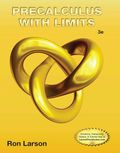
(a)
Find the parent function
(a)
Answer to Problem 40E
For the function
Explanation of Solution
Parent function is the basic function of a family of functions that preserves the definitions, shape of its graph and properties of the entire family.
Parent function used in this question is the absolute value function i.e
To identify the parent function, strip all the arithmetic operations on the function to leave behind one higher order operation in just x.
To identify the parent function, strip all the arithmetic operations on the function to leave behind one higher order operation in just x.
Conclusion:
So, remove the arithmetic operation of subtraction of 2 from 2 and multiplication by 1/2 and then subtraction of 3 from the given funcion to get the parent function.
(b)
Find the sequence of transformation from f to g.
(b)
Answer to Problem 40E
The shape of
Explanation of Solution
Given information:
Concept Used:
The sequence of transformations from ƒ to g depicts the steps followed and the transformations used to reach from the parent function ƒ to g.
The sequence of transformations from
Types of shifts used in function transfromation:
1. Vertical shift: If
If
2. Horizontal Shift:If
If
3. Reflection:The graph for the function say
The graph for the function say
4. Vertical Stretching and Shrinking:If
If
5. Horizontal Stretching and Shrinking:If
If
Conclusion:
The sequence of transformations from ƒ to g depicts the steps followed and the transformations used to reach from the parent function ƒ to g.
The shape of drawn reflected in the x-axis and stretched by by 1/2 units and then shifted downward by 3 units is the required sequence of transformations from ƒ to g.
(c)
To sketch the graph of
(c)
Answer to Problem 40E
Explanation of Solution
Given information:
Use parent functionsand then move them around the coordinate plane through various types of shifts and thus write one function in terms of the other.
Conclusion:
Obtain the graph of
(d)
To write
(d)
Answer to Problem 40E
Explanation of Solution
Given information:
Multiply
Chapter 1 Solutions
EBK PRECALCULUS W/LIMITS
- I need help in ensuring that I explain it propleryy in the simplifest way as possiblearrow_forwardI need help making sure that I explain this part accutartly.arrow_forwardPlease help me with this question as I want to know how can I perform the partial fraction decompostion on this alebgric equation to find the time-domain of y(t)arrow_forward
- Please help me with this question as I want to know how can I perform the partial fraction on this alebgric equation to find the time-domain of y(t)arrow_forwardEvaluate F³ - dr where ♬ = (4z, -4y, x), and C' is given by (t) = (sin(t), t, cos(t)), 0≤t≤ñ .arrow_forwardMid-Term Review Find the formula for (f + g)(x). f(x) = x² - 10x + 25 and g(x) = x² - 10x + 24 (f + g) (x) = [ 2 ]x² X + DELL Skip Sarrow_forward
- Calculus III May I please have some elaborations on Example 2 part a? Thank you.arrow_forward1. A bicyclist is riding their bike along the Chicago Lakefront Trail. The velocity (in feet per second) of the bicyclist is recorded below. Use (a) Simpson's Rule, and (b) the Trapezoidal Rule to estimate the total distance the bicyclist traveled during the 8-second period. t 0 2 4 6 8 V 10 15 12 10 16 2. Find the midpoint rule approximation for (a) n = 4 +5 x²dx using n subintervals. 1° 2 (b) n = 8 36 32 28 36 32 28 24 24 20 20 16 16 12 8- 4 1 2 3 4 5 6 12 8 4 1 2 3 4 5 6arrow_forward= 5 37 A 4 8 0.5 06 9arrow_forward
- Consider the following system of equations, Ax=b : x+2y+3z - w = 2 2x4z2w = 3 -x+6y+17z7w = 0 -9x-2y+13z7w = -14 a. Find the solution to the system. Write it as a parametric equation. You can use a computer to do the row reduction. b. What is a geometric description of the solution? Explain how you know. c. Write the solution in vector form? d. What is the solution to the homogeneous system, Ax=0?arrow_forward2. Find a matrix A with the following qualities a. A is 3 x 3. b. The matrix A is not lower triangular and is not upper triangular. c. At least one value in each row is not a 1, 2,-1, -2, or 0 d. A is invertible.arrow_forwardFind the exact area inside r=2sin(2\theta ) and outside r=\sqrt(3)arrow_forward
 Calculus: Early TranscendentalsCalculusISBN:9781285741550Author:James StewartPublisher:Cengage Learning
Calculus: Early TranscendentalsCalculusISBN:9781285741550Author:James StewartPublisher:Cengage Learning Thomas' Calculus (14th Edition)CalculusISBN:9780134438986Author:Joel R. Hass, Christopher E. Heil, Maurice D. WeirPublisher:PEARSON
Thomas' Calculus (14th Edition)CalculusISBN:9780134438986Author:Joel R. Hass, Christopher E. Heil, Maurice D. WeirPublisher:PEARSON Calculus: Early Transcendentals (3rd Edition)CalculusISBN:9780134763644Author:William L. Briggs, Lyle Cochran, Bernard Gillett, Eric SchulzPublisher:PEARSON
Calculus: Early Transcendentals (3rd Edition)CalculusISBN:9780134763644Author:William L. Briggs, Lyle Cochran, Bernard Gillett, Eric SchulzPublisher:PEARSON Calculus: Early TranscendentalsCalculusISBN:9781319050740Author:Jon Rogawski, Colin Adams, Robert FranzosaPublisher:W. H. Freeman
Calculus: Early TranscendentalsCalculusISBN:9781319050740Author:Jon Rogawski, Colin Adams, Robert FranzosaPublisher:W. H. Freeman
 Calculus: Early Transcendental FunctionsCalculusISBN:9781337552516Author:Ron Larson, Bruce H. EdwardsPublisher:Cengage Learning
Calculus: Early Transcendental FunctionsCalculusISBN:9781337552516Author:Ron Larson, Bruce H. EdwardsPublisher:Cengage Learning





